
IOWA WORKSMART
EMPLOYEE SELF-SERVICE
1

2
What are WorkSmart and Workday?
The Iowa WorkSmart
Project is the
implementation of
Workday, a single,
unified, state-of-the-art
cloud-based system used
for HR, Payroll, and
Finance business
processes.
Workday HCM
replaces the Human
Resources Information
System (HRIS) in Phase 1
and Workday FIN
replaces Integrated
Information for Iowa (I/3)
in Phase 2 of the
WorkSmart Project.
FINHCM
Workday
WorkSmart

3
Benefits of Workday
User
Friendly
Navigation
One Portal
Mobile
Functionality
Up-to-Date
• Designed like a consumer website, Workday is user friendly.
• By utilizing cloud-based technology, Workday provides information from one portal.
• Workday is easily available from anywhere, on any device which has an Internet connection.
• Workday provides semi-annual releases to ensure the latest software enhancements and
functionality are available.

HCM Scope
In Scope
• HCM Core
• Travel Expense Reimbursement
• Time Tracking
• Absence Management
• Payroll
• Compensation
• Benefits
• Onboarding
What’s In Scope?
Not in Scope
Recruiting (NeoGov)
Learning (LearnSoft)
Performance
4

Today I Need To…
• Hire someone in HRIS
• View State Contact information in Google
Contacts or SOI website
• Request vacation in eLeave or other system
• View paychecks in online payroll warrant
website
• Submit travel expenses in I3
Now
Future
Current Versus Future State
5

6
Future State -
Fundamentals
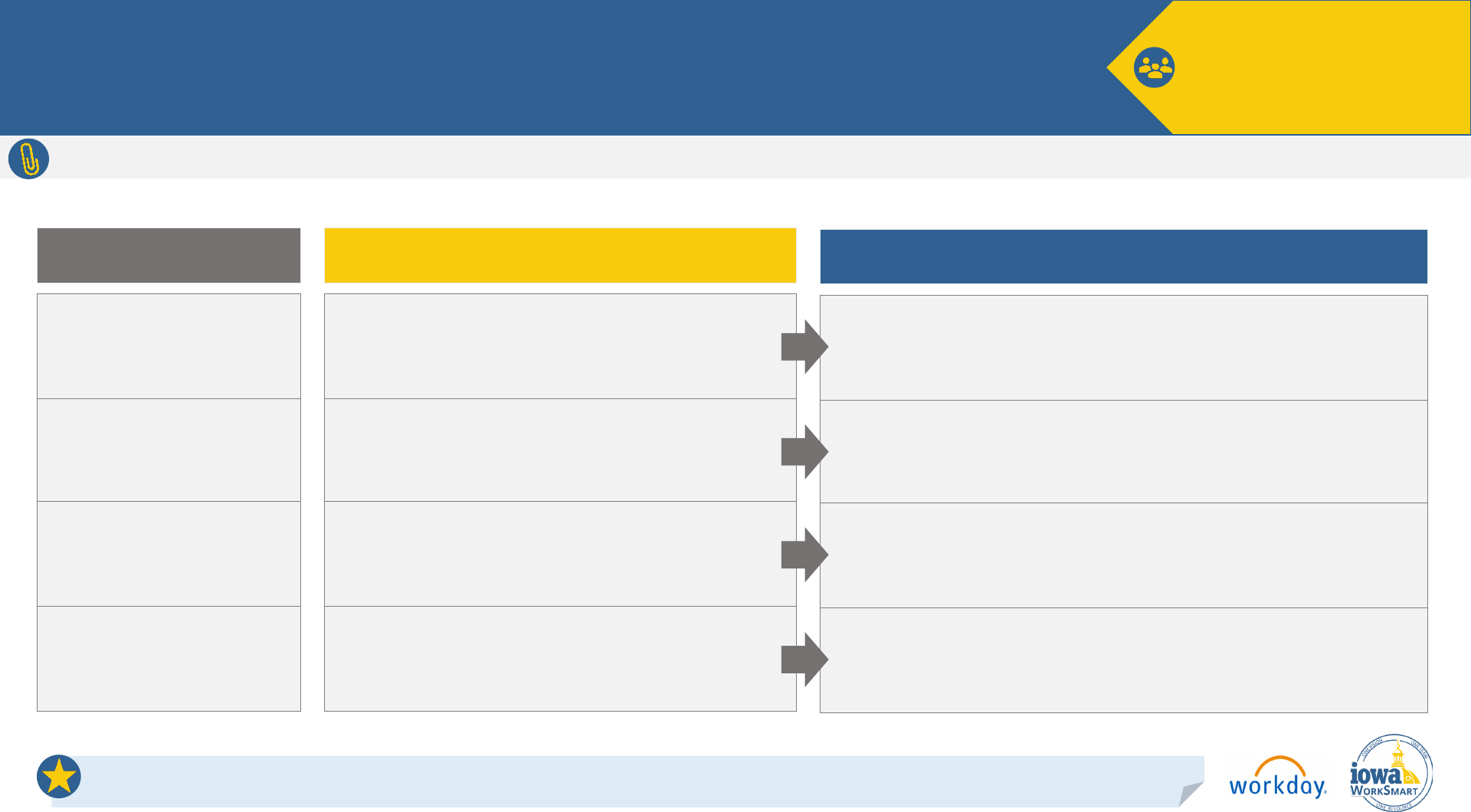
What is the Benefit? Ease of use, real-time data access, standardized processes, accessibility, cloud-based.
Workday Fundamentals
Current State
Future State
HRIS is used for HR functions and I/3 is used for Finance and
Accounting functions.
Workday will be implemented in a phased approach.
Phase 1: Workday HCM will replace HRIS and IowaBenefits.
Phase 2: Workday Financial Management (FIN) will replace I/3.
Legacy systems to Workday
Currently referred to as Span of Control, organizational charts are
often outdated and are not visible to employees in HRIS.
In Workday, Supervisory Organizations (Sup Orgs) are used to group employees into a
management hierarchy that provides structure for employee reporting relationships
and transactions. Sup Orgs are visible to all users through a clear visual that shows
team members and open positions.
Supervisory Organizations
The current Chart of Accounts, or list of financial accounts
available for recording transactions in the general ledger, is in I/3.
The Foundational Data Model, or FDM, is the multidimensional structure used across
HCM and Financials to tag and report on transactions. Our Transitional FDM for
Phase 1 is a subset of the I/3 Chart of Accounts mapped to Workday dimensions.
Foundational Data Model
Non-standard, often manual, paper-based processes exist.
Sets of tasks, such as initiating or approving a step, must be completed in Workday in
a certain order in the system for an event to occur. Tasks associated with Business
Processes are routed to users for completion based on their security. Examples of BPs
include Onboarding Setup, Enter Time, Request Time Off.
Business Processes (BPs)
Impacted Groups
• Managers
• Employees
• HRAs
What’s Changing?
Summary of Change: Statewide transition to Workday brings changes to terminology and some business processes along with new functionality.
7
7
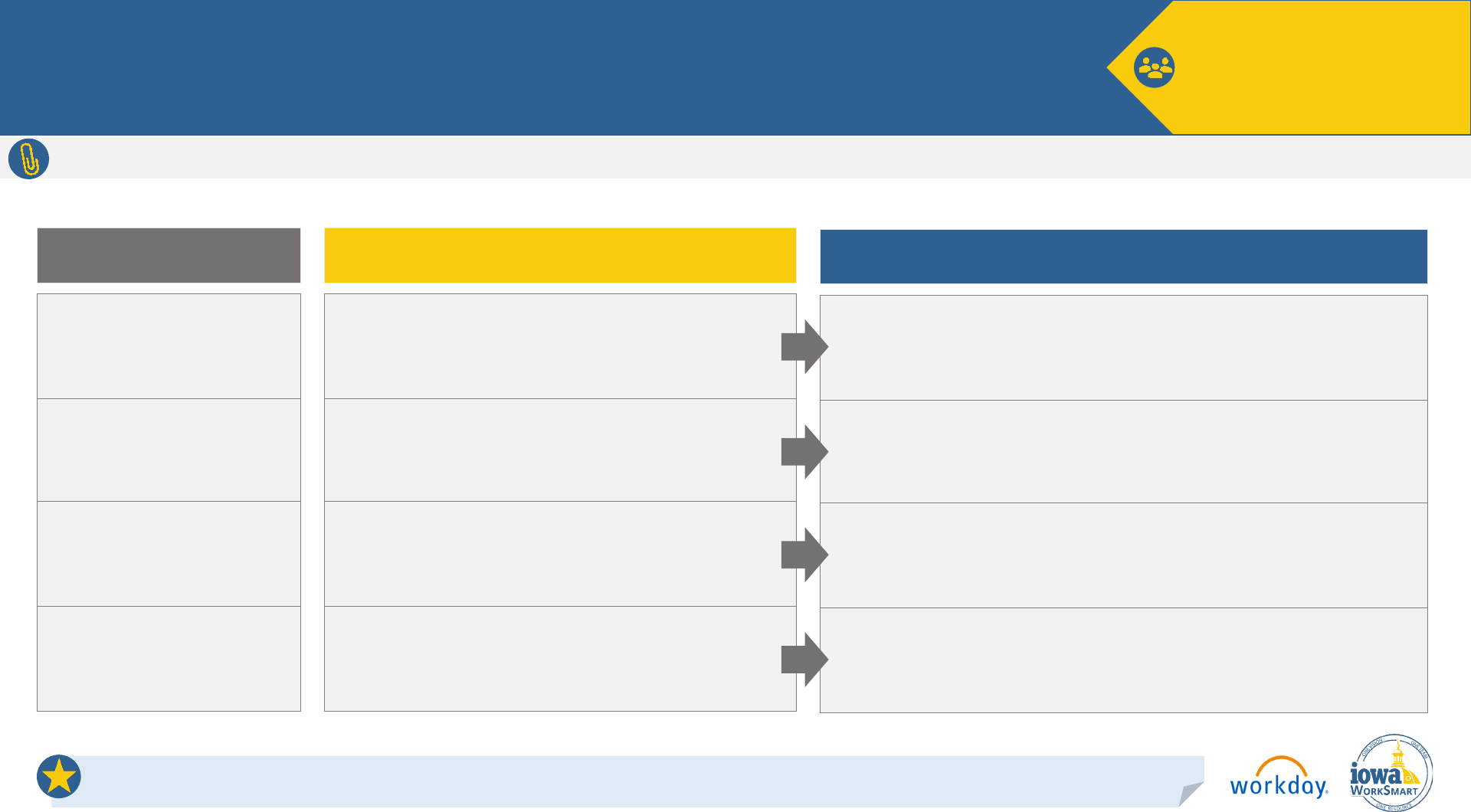
What is the Benefit? Ease of use, real-time data access, standardized processes, accessibility, cloud-based.
Workday Fundamentals
Current State
Future State
Legacy systems lack the modern navigation tools that users
appreciate in web-based systems.
Workday includes features and functionality not seen in the legacy systems, such as a
customizable homepage where announcements are posted and applications are
easily accessed, a robust search engine, an Inbox for receiving secure messages, and
a quick view to Notifications.
Ease of Use
HRIS does not incorporate accessibility features.
Workday is committed to designing products that all users can access. Users do not
require special configuration to enable their assistive technology to interact with
Workday.
Accessibility
HRIS does not offer ability to delegate tasks to a peer.
Users will have the ability to temporarily reassign select tasks to another user who
will be able to perform individual actions on behalf of the delegator for a specified
period of no longer than one year. The Delegate should be a person (peer or
supervisor) who already has access to the same information you do. All requests for
Delegation will go through an approval process.
Delegation
Reports must be compiled from one or more systems.
Workday has many standard delivered reports and offers the ability for an
organization to create custom reports. Access to reports is controlled by security
roles. A crosswalk is being built to map key current state to future state reports.
Reporting
Impacted Groups
• Managers
• Employees
• HRAs
What’s Changing?
Summary of Change: Statewide transition to Workday brings changes to terminology and some business processes along with new functionality.
What is the Benefit? Ease of use, real-time data access, standardized processes, accessibility, cloud-based.
8

9
Future State -
Employees

Name
Email
Phone
10
ESS enables
employees to view
and update their
personal
information and
easily initiate
requests.
Employee Self-Service (ESS)

What is the Benefit? Employees are enabled to view and update their personal information and easily initiate requests.
Employee Self-Service (ESS)
Current State
Future State
Newly hired employees fill out manual forms sent from several
different people.
When a new employee is hired into Workday, onboarding tasks are initiated for the
employee prompting them to enter personal information, set up payment elections,
elect benefits, and other onboarding tasks as determined by the agency or the
Manager. This may also apply to employees who change jobs.
Onboarding
Paper forms or other manual processes
Employees will initiate changes to personal information directly in Workday,
including: Home Address, Emergency Contacts, Title, Legal Name, Preferred Name,
Profile Photo.
Note: HRAs will be able to edit additional employee data that employees can’t edit,
such as Next Increase Date and passport or visa information.
Employee Personal Information
Personal email addresses are not stored in HRIS, but there are
personal email addresses in IowaBenefits for some employees.
Personal email addresses in IowaBenefits will be converted to Workday and
employees will enter and maintain personal email address in Workday moving
forward.
Personal email addresses
Veteran status is currently tracked in HRIS. Disability status is not
tracked in HRIS unless an employee has requested and been
approved for a reasonable accommodation.
Employees will be able to self identify as a Veteran in Workday (voluntary task at
Onboarding). HRAs will still update Disability status in Workday if an employee has
requested and been approved for a reasonable accommodation.
Disability Status and Veteran
Status
Impacted Groups
• Managers
• Employees
• HRAs
What’s Changing?
Summary of Change: Many tasks will be completed directly in Workday by employees rather than through submission of paper forms to HR or other
manual processes.
11

Employee Self-Service (ESS)
Current State
Future State
Current process allows one account plus select credit union
deductions and has an approval chain to catch errors.
Employees will change or update payment elections in Workday, electing up to 4
different banks or credit unions. When entering or changing a bank account,
employees will attach supporting documents in Workday. Workday will validate the
routing number. Any changes made by the employee to their bank account will
require HRA approval.
Employees currently fill out a form for Federal, State, and Local
withholding and give it to their HRA.
Tax withholding forms will be completed within Workday. HRA approval is only
needed if the employee is claiming exempt.
W-2s are either mailed directly to employees or given to
departments to share.
Employees may elect whether they want a paper or electronic W2. Workday defaults
to paper W-2 sent via mail, but employees can change this and view and download
their W-2 electronically.
Employees view pay slips in online warrant system.
https://www.egov.state.ia.us/warrants/warrantProcessorServlet
Pay slips for pay periods ending after the Workday Go-Live date will be accessible
within Workday. Pay slips will look a bit different than they do currently. The Payroll
team is putting together a crosswalk to assist employees with adjusting to the new
format.
Pay slips
Impacted Groups
• Managers
• Employees
• HRAs
What’s Changing?
Payment Elections
Electronic W-2
Tax Withholding Elections
Summary of Change: Many tasks will be completed directly in Workday by employees rather than through submission of paper forms to HR or other
manual processes.
What is the Benefit? Employees are enabled to view and update their personal information and easily initiate requests.
12

Employee Self-Service (ESS)
Current State
Future State
Benefits are elected in IowaBenefits during open enrollment and
for changes due to a life event.
Timing and communications around Open Enrollment will not change, but employees
will elect benefits in Workday. Requirements for benefit changes due to a life event
also remain the same, but employees will submit requests, make elections and
upload documentation in Workday.
Benefits Election
Employees add or change beneficiaries in IowaBenefits.
Employees will add or change beneficiaries in Workday.
Change Beneficiary
Employees add or change dependents in IowaBenefits. There is
no trigger to add/change dependents when benefits change due
to a life event.
Employees will initiate changes to dependents within Workday. Employees who
make a change in benefits as a result of a life event such as birth or adoption will be
prompted to add the dependent as part of the task.
Add/Change Dependent
Currently known as the Retirement Investment Club (RIC),
employees select a vendor, fill out a form, and meet with the
vendor to establish the account.
Deferred compensation will be elected directly in Workday. Employees will initiate
the process and will elect to contribute a percent or flat rate. No approvals are
needed. Employees will be able to see all benefit deductions in one place.
Deferred Compensation
Impacted Groups
• Managers
• Employees
• HRAs
What’s Changing?
Summary of Change: Many tasks will be completed directly in Workday by employees rather than through submission of paper forms to HR or other
manual processes.
What is the Benefit? Employees are enabled to view and update their personal information and easily initiate requests.
13

Employee Self-Service (ESS)
Current State
Future State
Travel Department Authorization (TDA) used for pre-
authorization.
Spend Authorizations will be done in Workday. Note that Spend Authorizations are
only for out-of-state/international travel so this doesn’t impact most employees.
Spend Authorizations
Travel Payment (TP) document is used for submitting expenses
for reimbursement, including travel expenses.
Expense reports for reimbursement of travel expenses will be entered and approved
in Workday. Employees can initiate the request, or a member of the financial team
can initiate it for them. Receipts are still required per policy. Non-travel expenses will
continue to be processed through a TP form until Phase 2.
Travel Expenses
There is currently no mobile functionality for submitting expenses
Workday provides functionality for employees to view, edit, and submit Spend
Authorizations and Expense Reports via mobile devices. Photos of receipts can be
captured and uploaded to Workday.
Travel card expenses are manually entered and submitted on a
TP document.
After go-live, Travel card expenses will be automatically loaded into Workday,
reducing the amount of manual input by employees.
Travel Cards
Impacted Groups
• Managers
• Employees
• HRAs
What’s Changing?
Mobile Functionality for Expenses
Summary of Change: Many tasks will be completed directly in Workday by employees rather than through submission of paper forms to HR or other
manual processes.
What is the Benefit? Employees are enabled to view and update their personal information and easily initiate requests.
14
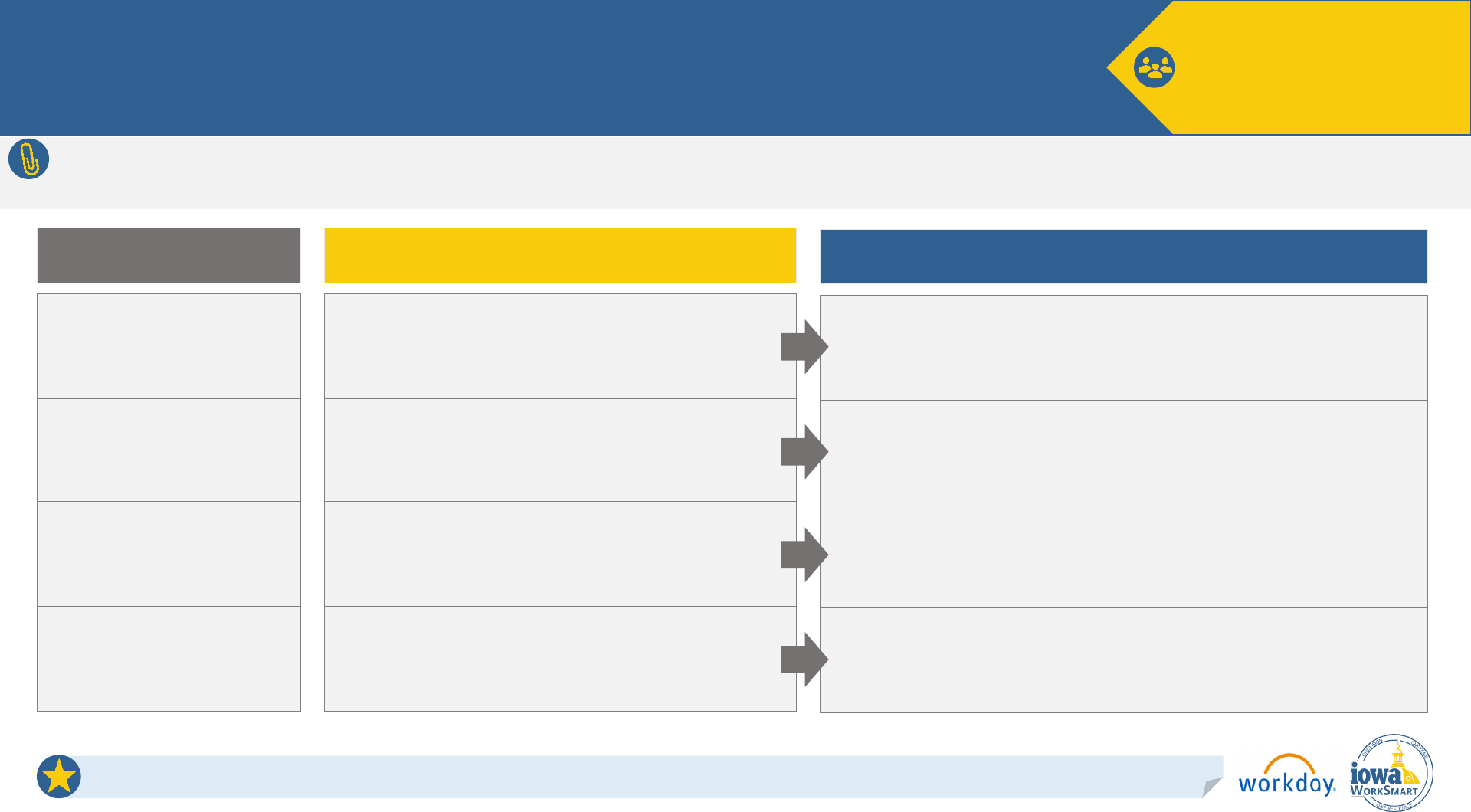
Employee Self-Service (ESS)
Current State
Future State
There is a default timesheet in HRIS that shows the number of
hours but not the start and end times. If an employee has access
to their work schedule in HRIS, they can change it anytime they
want.
Employees may select/request a pre-configured work schedule from a list. The
request will route to their Manager for approval. Schedules are used in Workday’s
validation of time off and time tracking, so having an accurate total hours for each
day is essential. The work schedule drives many things downstream such as holiday/
comp/overtime pay, ability to request time off, and payroll for exempt employees .
Work Schedules
In HRIS, time worked and time off are both entered directly on
the timesheet.
In Workday, separate processes are used for entering time worked and time off.
Non-exempt employees will enter and submit time worked through the Time Entry
Calendar. Exempt employees are not required to enter time unless certain conditions
are met. Workday routes submitted time for approval. Note that the Time Entry
Calendar does display time off and holidays but is not used to request time off.
Time Entry – most agencies
Some agencies use Kronos, Unanet, TARs, TRACS, or LPS to enter
time worked.
Some agencies will continue to use external time tracking systems that will integrate
with Workday. Time entered outside of Workday will be uploaded to Workday time
tracking via an integration each pay period. Workday will be the system of record
regardless of whether time is directly entered or sent through an integration.
Time Entry - exceptions
If a timesheet processes with incorrect hours in HRIS, there is no
way to correct the timesheet. Instead, HRAs have to do manual
adjustments to correct the employee’s pay and/or time off.
Employees will navigate to their previous submission in the Time Entry Calendar and
correct their time in the same manner in which they entered it. Managers will need
to approve the correction.
Time Corrections
Impacted Groups
• Managers
• Employees
• HRAs
What’s Changing?
Summary of Change: Many tasks will be completed directly in Workday by employees rather than through submission of paper forms to HR or other
manual processes.
What is the Benefit? Employees are enabled to view and update their personal information and easily initiate requests.
15

Employee Self-Service (ESS)
Current State
Future State
Some agencies track time to projects using functionality in HRIS.
As part of time entry, some agencies will have the ability to track activity in Workday
using custom worktags called Work Reporting Codes. This is a temporary solution as
Phase 2 of WorkSmart will bring Project Management functionality to all agencies.
Work Reporting Codes
All time away is commonly referred to as time off.
Workday makes distinctions between Time Off and Leave of Absence (LOA). For Time
Off, expected return date is typically known up front and the employee remains an
‘active’ worker. Examples include vacation, sick, jury duty, banked holidays. For LOA,
return date may be estimated and employee status is changed to “On Leave”.
Examples include FMLA, Medical, Workers’ Compensation, Military Leave.
Terminology – Time Off
Employees request time off through email, in person, or via an
external system, and then reflect that time off was used when
completing their timesheet. There is generally no comprehensive
view of upcoming time off for individuals or teams.
Employees will access the Workday Absence Calendar to view, enter, edit, submit,
and correct their time off. They will also be able to see when team members are off
but will not be able to see the reason for the colleague’s absence.
Absence Calendar
FMLA is out-sourced to an FMLA Administrator.
Employees will have the ability to request a Leave of Absence in Workday. When the
employee is ready to return, their manager will complete a request in Workday to
return the employee to work.
FMLA
Impacted Groups
• Managers
• Employees
• HRAs
What’s Changing?
Summary of Change: Many tasks will be completed directly in Workday by employees rather than through submission of paper forms to HR or other
manual processes.
What is the Benefit? Employees are enabled to view and update their personal information and easily initiate requests.
16
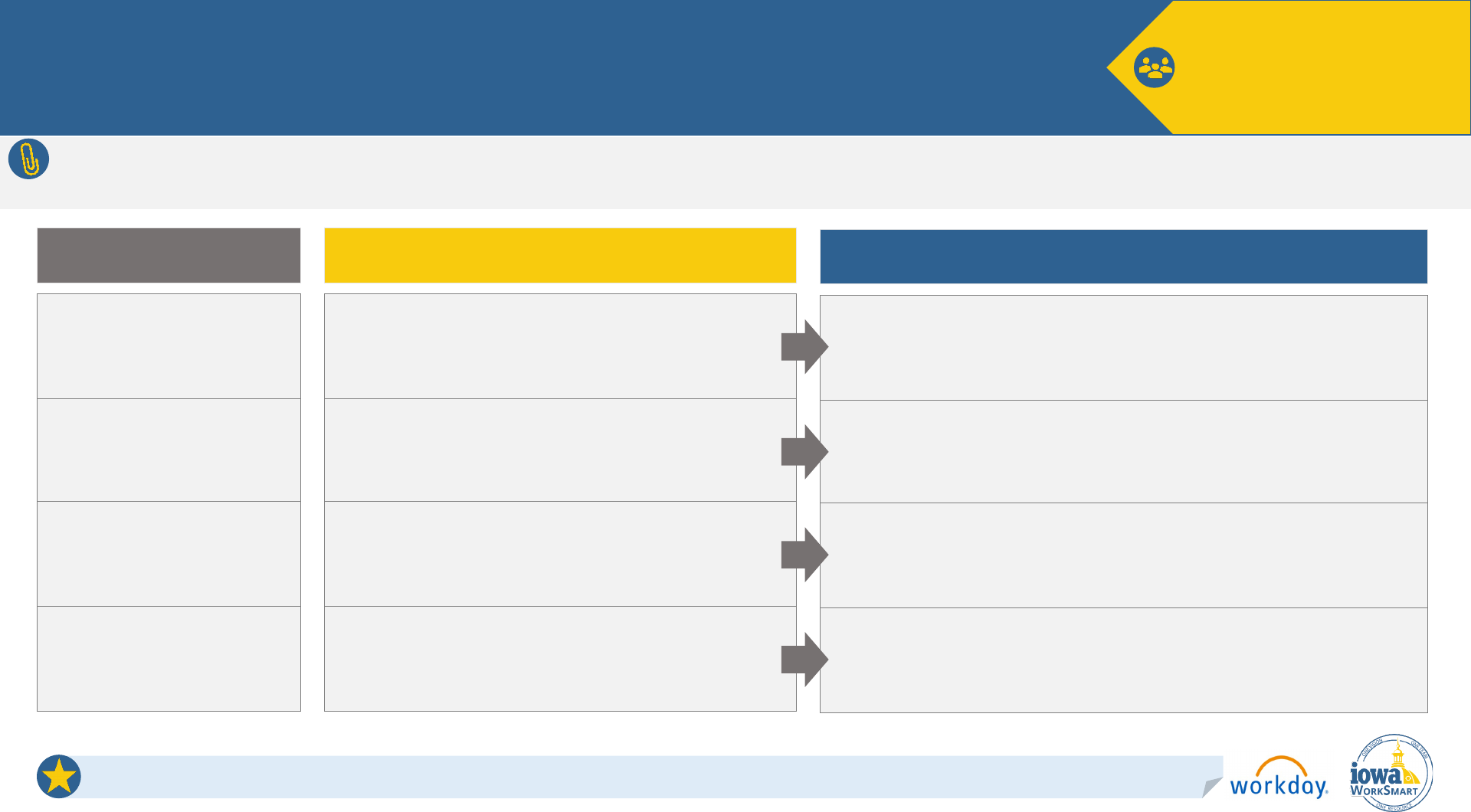
Employee Self-Service (ESS)
Current State
Future State
During FMLA, employees can elect to retain some vacation hours
A paper form is received from an HRA, completed, and returned
to the HRA.
Leave Retention will be managed within Workday as part of the Request Leave of
Absence business process. When the employee is put on an applicable leave, they
will receive an Inbox item about Leave Retention.
Leave Retention Request
A flag (checkbox) is on the timesheet in HRIS to elect conversion
of sick time to vacation time. The employee can select the
checkbox and leave it selected for future pay periods. A warning
will display if they don't have enough time to convert.
Employees will elect to convert sick time to vacation time in Workday by turning on a
Sick Conversion flag in their worker record. The employee will enter an effective date
and the flag will remain on until the employee or HRA turns it off. When the flag is
on, Workday will automatically process the conversion in any conversion pay period
in which the employee is eligible to convert.
Sick Conversion
SPOC employees may convert vacation to sick leave once per
fiscal year and upon retirement. The employee completes a
paper form that is sent to the HRA, who then enters the
conversion in HRIS.
Vacation conversion will be requested from the Absence Calendar and the employee
can only convert once per fiscal year unless they also retire in the year that the
conversion was made.
Vacation Conversion - SPOC
The HRA currently enters the request in HRIS after receiving a
form from the employee with hours requested. The HRA checks
the vacation balance, and inputs in the system if valid.
Employees will be able to make their vacation payout election in Workday if their
agency is participating in the payout. The system will check the employee’s vacation
balance to ensure it is at least 160 hours and HRA approval will not be required.
Annual Vacation Buyout
Impacted Groups
• Managers
• Employees
• HRAs
What’s Changing?
Summary of Change: Many tasks will be completed directly in Workday by employees rather than through submission of paper forms to HR or other
manual processes.
What is the Benefit? Employees are enabled to view and update their personal information and easily initiate requests.
17
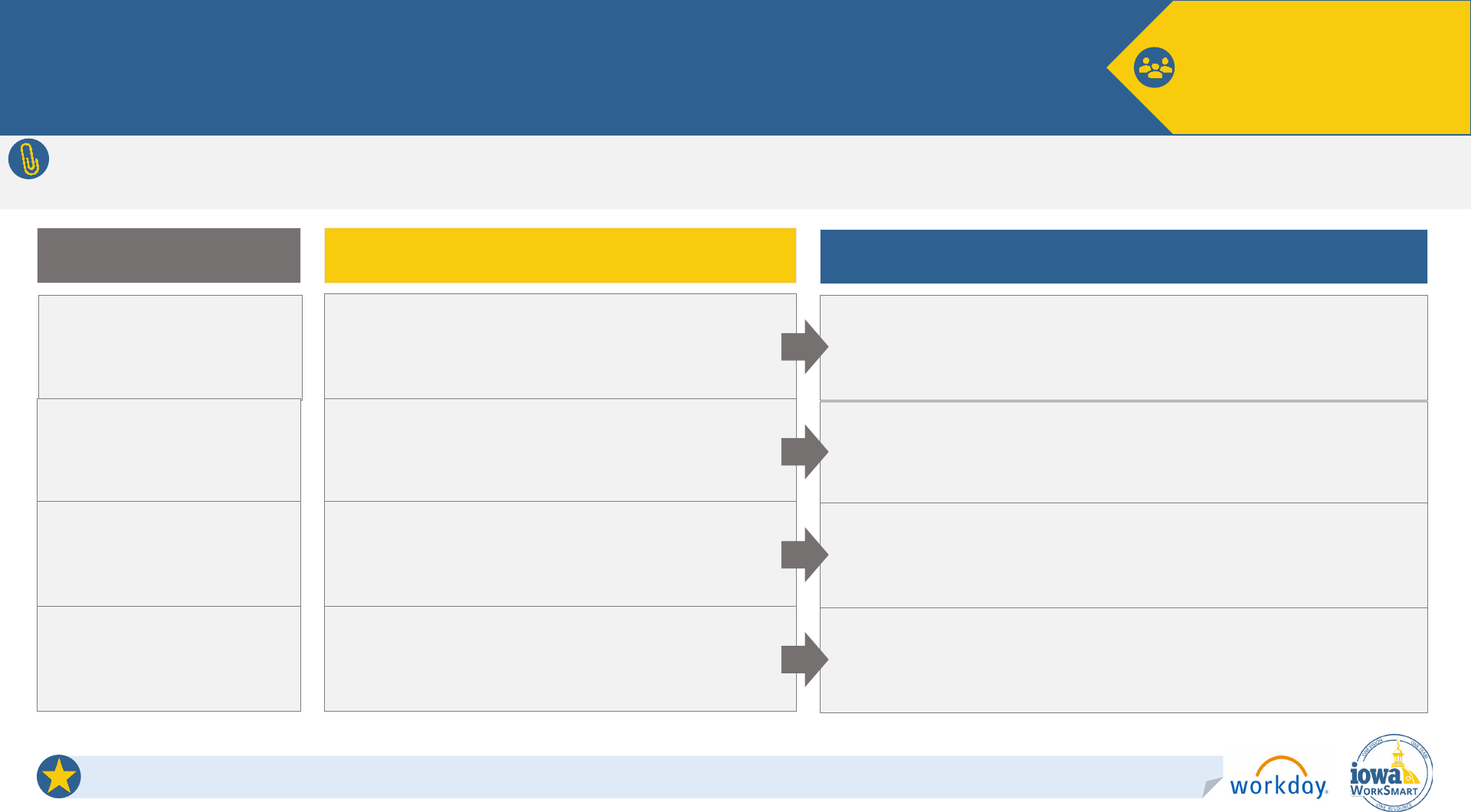
Employee Self-Service (ESS)
Current State
Future State
Currently, employees and/or HRAs can change overtime hours to
comp earned by changing the time type on the timesheet. For
employees whose time is loaded via integration or entered in
PAYN, the comp time election is communicated via email or in
Kronos and the HRA enters the comp time hours.
Overtime will be calculated in Workday even when time worked is submitted through
an integration. Employees will have access to enter comp earned for any overtime
hours.
Changing overtime to comp time
Employees have limited ability to see their accrued hours.
Time off accruals will be calculated and displayed in Workday. Workday employee
self service allows employees to view personal information at will. Note that
Workday shows the current period accrual added to an employee’s balance as of the
period end date and Workday will not let an employee use it until the next day. There
is no change in the accrual policy, but the display is different.
Accrual balances
Catastrophic leaves donations are currently done using paper
forms and employees can only donate vacation hours.
Employees will be able to create a request in Workday to donate vacation hours to
an employee who is eligible to receive donations. The donated leave process will be
handled by the Leave Manager who will use the donor’s hours and apply them to the
recipient as they are needed and in accordance with DAS-HRE rules.
Catastrophic Leave Donations
Employees do not have access to HRIS once employment ends.
Terminated employees will have self-service access in Workday for one year from
their last date of employment. This will be useful for retrieving pay warrants and
W-2s and viewing the COBRA notice and information about their service.
Access to data after termination
Impacted Groups
• Managers
• Employees
• HRAs
What’s Changing?
Summary of Change: Many tasks will be completed directly in Workday by employees rather than through submission of paper forms to HR or other
manual processes.
What is the Benefit? Employees are enabled to view and update their personal information and easily initiate requests.
18

Employee Self-Service (ESS)
Current State
Future State
Employees have insight into the cost incurred by the State for
benefits through the Iowa Online Payroll Warrant report.
Workday provides the employee with an understanding of the total value of their
compensation package, including base and variable pay, medical plans, life insurance,
and other benefits visually through a pie chart graph.
Total Rewards
Impacted Groups
• Managers
• Employees
• HRAs
What’s Changing?
Summary of Change: Many tasks will be completed directly in Workday by employees rather than through submission of paper forms to HR or other
manual processes.
What is the Benefit? Employees are enabled to view and update their personal information and easily initiate requests.
19
Once a year campaign, employees can set up one-time payment
or recurring.
Employees will be able to make OneGift elections in Workday during the annual
campaign. Any changes made after that date will need to be completed by the HRA.
OneGift Pledge

